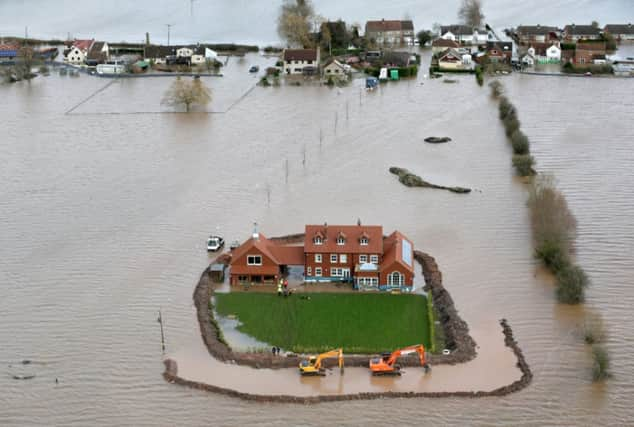How flooding is a growing issue


The widespread floods in parts of the UK this winter resulted in areas of agricultural land being under water for days, and in some cases weeks, on end.
Much of the media focus at the time was on the daily struggle to lead an ordinary life during the floods but in the face of a changing climate, with more extreme weather events predicted, it is important to consider the impact of flooding on agricultural soils and food production.
Advertisement
Hide AdAdvertisement
Hide AdNow that the waters have finally receded farmers are assessing the state of their land and potential losses they face. We are yet to see the impact but losses will depend on differences in land use and crop value and can be significant both in the short and longer term.
A report for Defra on the 2007 floods in England valued crop loss at between £180 and £711 per hectare, for winter barley, and between £2,150 and £3,300 per hectare for potatoes under low and high impact scenarios.
Within Scotland the eastern region produces the majority of cereal and potato crops with an estimated 420,000 hectares of land used for barley, wheat and potato production.
Should flooding occur here at the scale seen in England the losses could easily run into many thousands.
Using current prices even a low impact event could result in losses of £200/ha and £4,200/ha, for cereals and potatoes respectively.
More serious, higher impact, events could result in losses of £850/ha and £6,500/ha for cereals and potatoes. Real costs to farmers would likely be significantly higher.
The figures quoted above only include losses of marketable crop value and not the other myriad costs associated with flooding.
These would likely include damage to buildings and infrastructure, losses of soil through erosion, nutrient leaching, greenhouse gas emissions and also degradation in general soil health.
Advertisement
Hide AdAdvertisement
Hide AdSoil susceptibility to flooding or waterlogging depends on factors such as the climate; external drainage; topology and the soil’s internal drainage. The efficiency with which the soil can cope with excessive water largely depends on its structure including pore spaces (air spaces).
Typically clay soils or compacted have few large pore spaces and drain much slower than well-structured or sandy soils which have larger pore spaces and tend to have greater ability to drain quicker. The severity of flooding therefore varies with the worst case scenario where all pores in the soil are filled with water for an extended period of time.
All flooding is detrimental to plant growth, due to reduced oxygen availability, with the most severe impact occurring when it coincides with a phase where growth is normally rapid.
Plants can adapt to some extent but yield is typically reduced due to reduced photosynthesis, the engine room of growth. Different plants respond in different ways depending on the species or variety, the stage of the plant’s life cycle and the duration, water depth and frequency of the flooding. One typical response is for roots to develop air channels, aerenchyma, which allows increased oxygenation of roots; the classic example of this is paddy rice. However, it is unclear the extent that these can be produced, the time it takes for them to establish and if this is relevant to flooding of typical agricultural soils.
However, timing of flood events is not just critical for plant growth. If flooding occurs when suitable nitrogen compounds are available, for example soon after fertilisation, a significant loss of nitrogen from the system can occur. This can be through leaching of soluble nitrate from soil or through microbial denitrification (a process that helps some microbes to respire in the absence of oxygen) which results in the release of the potent greenhouse gas nitrous oxide.
Thus fertilisation timings become critical under climate change scenarios where rainfall is likely to be more intense and sporadic. Research at the James Hutton Institute includes projects, funded by the Scottish Government and other bodies, which aim to prevent and minimise flooding and to understand the impacts on plants and soils including leaching and denitrification.
This knowledge will help improve management strategies, the development of crop varieties able to cope and improve resilience in a challenging environment.
It is perhaps too early to say whether this winter’s floods will push up food prices in the shops. What is clear is that with floods becoming more extreme and potentially increasing in frequency, more research into the impacts on agriculture, and potential measures to reduce the impacts, are essential.
Advertisement
Hide AdAdvertisement
Hide Ad• Dr Kenneth Loades is a research leader at the James Hutton Institute, and worked on this article with Dr Tim Daniell and Dr Blair McKenzie, from the Delivering Sustainable Production Systems Research Theme at the Institute www.hutton.ac.uk/sps
SEE ALSO